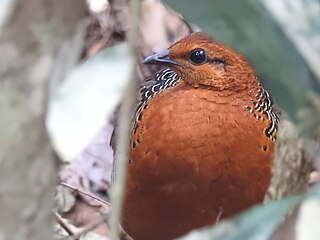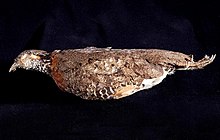
A partridge is a medium-sized galliform bird in any of several genera, with a wide native distribution throughout parts of Europe, Asia and Africa. Several species have been introduced to the Americas. They are sometimes grouped in the Perdicinae subfamily of the Phasianidae. However, molecular research suggests that partridges are not a distinct taxon within the family Phasianidae, but that some species are closer to the pheasants, while others are closer to the junglefowl.

The chestnut-bellied partridge also known as chestnut-bellied hill-partridge or Javan hill-partridge is a small, up to 28 cm long, partridge with a rufous crown and nape, red legs, grey breast, brown wings, red facial skin, and a black mask, throat and bill. It has a rufous belly with white on the middle. The sexes are similar. The young has a whitish face and a reddish brown bill.

The Hainan partridge is a species of bird in the family Phasianidae. It is endemic to Hainan Island, China. Its natural habitats are primary evergreen forests. It is threatened by habitat loss and has been assessed as a vulnerable species.

Arborophila is a bird genus in the family Phasianidae. The genus has the second most members within the Galliformes after Pternistis, although Arborophila species vary very little in bodily proportions with different species varying only in colouration/patterning and overall size. These are fairly small, often brightly marked partridges found in forest of eastern and southern Asia. Some species in this genus have small ranges, and are threatened by habitat loss and hunting.

The bar-backed partridge, also known as the brown-breasted hill-partridge, is a species of partridge in the family Phasianidae. It is found in southwestern China and Southeast Asia.
The chestnut-headed partridge is a bird species in the family Phasianidae. It is found in highland forest in Cambodia. Some taxonomists consider the Siamese partridge conspecific.

The Taiwan partridge or Taiwan hill partridge is a species of bird in the family Phasianidae. It is found only in Taiwan, and its natural habitat is broadleaf forests. It is threatened by habitat loss, but at present is categorised by the International Union for Conservation of Nature (IUCN) as being of least concern.
The orange-necked partridge is a species of bird in the family Phasianidae. It is found in eastern Cambodia and southern Vietnam. Its habitats are lowland forests, shrubland, and plantations. It was described in 1927 and rediscovered in 1991. It is threatened by habitat loss, and the International Union for Conservation of Nature (IUCN) has assessed it as a near-threatened species.

The white-necklaced partridge, also known as the collared partridge or Rickett's hill-partridge, is a species of bird in the family Phasianidae. It is endemic to southeastern China. It is threatened by habitat loss and hunting, and the IUCN has assessed it as near-threatened.

The red-breasted partridge, also known as the Bornean hill-partridge, is a species of bird in the family Phasianidae. It is endemic to hill and montane forest in Borneo, preferring bamboos and thickets. The International Union for Conservation of Nature (IUCN) has assessed it as a least-concern species.

The rufous-throated partridge is a species of bird in the family Phasianidae. It is found in montane forests in India and Southeast Asia. The International Union for Conservation of Nature (IUCN) has assessed it as a least-concern species.
The Sumatran partridge, or Sumatran hill partridge, is a bird species in the family Phasianidae. It is found in highland forest in central Sumatra, Indonesia. It is sometimes treated as a subspecies of the grey-breasted partridge.

The ferruginous partridge is a species of bird in the family Phasianidae. It belongs to the monotypical genus Caloperdix. It is found in Indonesia, Malaysia, Myanmar, and Thailand.

The crestless firebacks are a group of two species of bird in the family Phasianidae. They are found in Brunei, Indonesia, Malaysia, and Singapore. Their natural habitat is subtropical or tropical moist lowland forests. They are threatened by habitat destruction.

The dark-backed wood quail is a bird species in the family Odontophoridae, which is the New World quail. It is found in Colombia and Ecuador.
The Vietnam partridge, Annam partridge, or Annam hill partridge, Tropicoperdix chloropus merlini, is now usually considered a subspecies of the green-legged partridge in the family Phasianidae of birds.

Perdicinae is a polyphyletic former subfamily of birds in the pheasant family, Phasianidae, regrouping the partridges, Old World quails, and francolins. Although this subfamily was considered monophyletic and separated from the pheasants, tragopans, junglefowls, and peafowls (Phasianinae) till the early 1990s, molecular phylogenies have shown that these two subfamilies actually constitute only one lineage. For example, some partridges are more closely affiliated to pheasants, whereas Old World quails and partridges from the Alectoris genus are closer to junglefowls. Due to this, the subfamily Perdicinae is no longer recognized by the International Ornithological Congress, with the species being split among 3 subfamilies.
Roll's partridge is a bird species in the family Phasianidae. It is found in highland forest in northern Sumatra, Indonesia. It is sometimes treated as a subspecies of the grey-breasted partridge.

Tropicoperdix is a genus of three species of birds in the pheasant family, Phasianidae. Although formerly classified in the now-defunct subfamily Perdicinae, phylogenetic evidence supports them being a sister group to the tribe Polyplectronini. They are referred to as East Asian forest partridges.

The Sabah partridge is a bird species in the family Phasianidae. It is found in Borneo.














